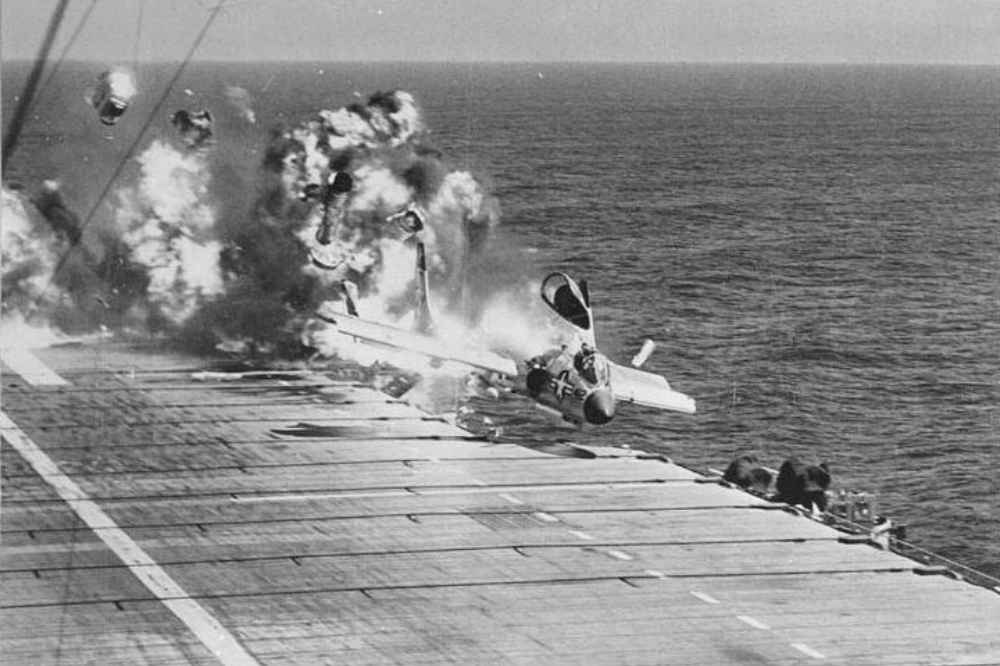The F7U Cutlass burst onto the aviation scene like a visitor from the future straight into the 1950s. Its radical design, featuring a tailless silhouette and dramatically swept wings anchored to a short, robust fuselage, defied the conventions of the time, looking more like a starship than an aircraft.
This Cutlass boasted an uncommon twin-engine configuration, a rarity for fighters during this period. It was powered by twin Westinghouse J34 turbojets flanking the fuselage, which not only provided blistering thrust but also endowed the F7U with a spacecraft-like visage. The power plants were ingeniously integrated, with air intakes boldly positioned at the forward sides of the fuselage, sharpening its aggressive, angular profile.
Moreover, the F7U was a trailblazer in incorporating power-boosted hydraulic controls, a groundbreaking advancement that enabled crisper handling and nimble maneuverability at soaring speeds and dizzying altitudes. It also came equipped with an ejection seat, a vital safety mechanism in the high-stakes era of jet experimentation.
However, when this sci-fi-like aircraft took to the skies, it turned into a nightmare. Its ambitious, tailless design caused dismal stability and control issues. Underpowered and unreliable engines, combined with severe structural deficiencies, earned the aircraft a notorious reputation as a deathtrap. Fatal accidents increased, including one where the pilot ejected, leaving the Jet to fly out of control around San Diego for half an hour. Whispers spread about the Cutlass’s problematic “Nazi DNA.”
The question loomed large: Had the seized German research, which laid the groundwork for the F7U, been the catalyst for its catastrophic failures? Could the Cutlass be redeemed?
The Vought F7U Cutlass was a United States Navy carrier-based jet fighter and fighter-bomber designed and produced by the aircraft manufacturer Chance Vought. It was the first tailless production fighter in the United States as well as the Navy’s first jet equipped with swept wings and the first to be designed with afterburners.
The Cutlass was developed from the mid 1940s to early 1950s as Vought’s entry in a United States Navy competition. Their design team, which was influenced by design information obtained from Nazi Germany, opted for a tailless configuration paired with low aspect ratio swept wings, which was regarded as a radical departure from traditional aircraft design for the era. Vought’s submission was favoured by Navy officials and was declared the winner in 1946. On 29 September 1948, the prototype performed its maiden flight; all three prototypes would be lost during the flight test program. It was initially powered by a pair of Westinghouse J34 turbojet engines which were relatively underpowered, contributing to its accident-prone nature; its unreliable hydraulic flight control system was also a source of difficulties.

Ramp strike of Vought F7U-3 Cutlass BuNo 129595, Modex 412, of VF-124 on the USS Hancock on 14 July 1955. LCDR Jay T. Alkire (XO of USN’s VF-124 “Stingrays”) was killed in the crash, and several deck crew were injured
The first production model of the Cutlass, F7U-1, entered service during July 1951. It was promptly followed by F7U-2 and F7U-3, improved models that were equipped with more powerful engines amongst other refinements. However, the Cutlass continued to suffer from frequent technical and handling problems throughout the aircraft’s short service career. Accidents involving the type were responsible for the deaths of four test pilots and 21 other U.S. Navy pilots. Over one quarter of all Cutlasses built were destroyed in accidents; this high rate of accidents led to the type being withdrawn during the late 1950s despite having been in service for less than ten years.
Background
The Cutlass was developed in response to a competition organised by the United States Navy for a new carrier-capable day fighter that was launched on 1 June 1945. Specific requirements of the competition included that ability to fly at speeds of up to 600 miles per hour (970 km/h) and altitudes of up to 40,000 feet (12,000 m). Vought decided to respond with a relatively radical design for the era.
Vought’s design team opted for an unconventional tailless configuration; this decision was heavily influenced by aerodynamic data obtained for various wartime projects undertaken by the German Arado and Messerschmitt companies that had been obtained at the close of World War II through German scientists who worked on the projects, though Vought designers denied any link to the German research at the time. Specifically, former Messerschmitt AG senior designer Woldemar Voigt, who supervised the development of numerous experimental jet fighters in Nazi Germany, contributed to its design with his experience in the development of the Messerschmitt P.1110 and P.1112 projects.The F7U was the last aircraft designed by Rex Beisel, who was responsible for the first fighter ever designed specifically for the U.S. Navy, the Curtiss TS-1 of 1922.
Vought’s design was given the company type number V-346 and later received the official designation of F7U when the aircraft was announced to be the winner of the competition. Reviewing official found the design, despite its unconventional nature, to pose an acceptable level of risk, less so than some of the competing submissions. During June 1946, an initial order for three XF7U-1 prototypes, each powered by a pair of Westinghouse J34 turbojet engines, was issued to the company. Construction took place at Vought’s plant in Stratford, Connecticut.
Top Photo: A U.S. Navy Vought F7U-3 Cutlass (BuNo 128464) from Air Development Squadron VX-3 out of Naval Air Station Atlantic City, New Jersey (USA), in flight, 15 January 1954.
Sources: YouTube; Wikipedia


